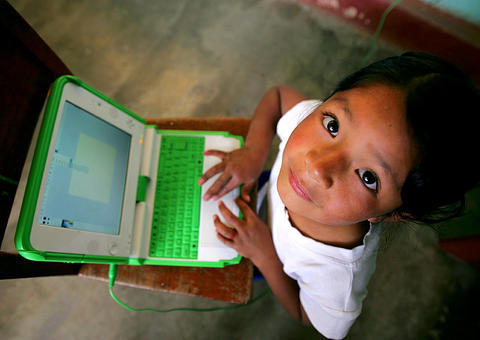Doubts about whether poor, rural children really can benefit from quirky little computers evaporate as quickly as the morning dew in this hilltop Andean village, where 50 primary school children got machines from the One Laptop Per Child project six months ago.
These offspring of peasant families whose monthly earnings rarely exceed the cost of one of the US$188 laptops -- people who can ill afford pencil and paper much less books -- can't get enough of their "XO" laptops.
At breakfast, they're already powering up the combination library/videocam/audio recorder/music maker/drawing kits. At night, they're dozing off in front of them -- if they've managed to keep older siblings from waylaying the coveted machines.

PHOTO: AP
"It's really the kind of conditions that we designed for," Walter Bender, president of the Massachusetts Institute of Technology (MIT) spinoff program One Laptop Per Child, said of this agrarian backwater up a precarious dirt road.
Founded in 2005 by former MIT Media Lab director Nicholas Negroponte, One Laptop has retreated from early boasts that developing-world governments would snap up millions of the pint-sized laptops at US$100 each.
In a backhanded tribute, One Laptop now faces homegrown competitors everywhere from Brazil to India -- and a full-court press from Intel Corp's more power-hungry Classmate.
ONE STEP AHEAD
But no competitor approaches the XO in innovation. It is hard drive-free, runs on the Linux operating system and stretches wireless networks with "mesh" technology that lets each computer in a village relay data to the others.
Mass production began last month and Negroponte says he expects at least 1.5 million machines to be sold by November. Even that would be far less than Negroponte originally envisioned. The higher-than-initially-advertised price and a lack of the Windows operating system, still being tested for the XO, have dissuaded many potential government buyers.
Peru made the single biggest order to date -- more than 272,000 machines -- in its quest to turn around a primary education system that the World Economic Forum recently ranked last among 131 countries surveyed. Uruguay was the No. 2 buyer of the laptops, inking a contract for 100,000.
Negroponte said 150,000 more laptops will get shipped to countries including Rwanda, Mongolia, Haiti, and Afghanistan early next year through "Give One, Get One," a US-based promotion ending Dec. 31 in which people buy a pair of laptops for US$399 and donate one or both.
REVOLUTION
The children of Arahuay prove One Laptop's transformative conceit: that you can revolutionize education and democratize the Internet by giving a simple, durable, power-stingy but feature-packed laptop to the worlds' poorest kids.
"Some tell me that they don't want to be like their parents, working in the fields," first-grade teacher Erica Velasco says of her pupils. She had just sent them to the Internet to seek out photos of invertebrates -- animals without backbones.
"What they work with most is the [built-in] camera. They love to record," said Maria Antonieta Mendoza, an Education Ministry psychologist studying the Arahuay pilot project to devise strategies for the big rollout when the new school year begins in March.
Before the laptops, the only cameras the kids at Santiago Apostol school saw in this hamlet of 800 people were carried by tourists coming for festivals or the local Inca ruins.
Arahuay's lone industry is agriculture. Surrounding fields yield avocados, mangoes, potatoes, corn, alfalfa and an Andean fruit called cherimoya.
Many adults share only weekends with their children, spending the work week in fields many hours' walk from town and relying on charities to help keep their families nourished.
When they finish school, young people tend to abandon the village.
Peru's head of educational technology, Oscar Becerra, is betting the One Laptop program can reverse this rural exodus to the squalor of Lima's shantytowns four hours away.
It's the best answer yet to "a global crisis of education" in which curricula have no relevance, he said. "If we make education pertinent, something the student enjoys, then it won't matter if the classroom's walls are straw or the students are sitting on fruit boxes."
Indeed, Arahuay's elementary school population rose by 10 when families learned the laptop pilot was coming, said Guillermo Lazo, the school's director.
The XOs that Peru is buying will be distributed to pupils in 9,000 elementary schools from the Pacific to the Amazon basin where a single teacher serves all grades, Becerra said.
Although Peru boasts thousands of rural satellite downlinks that provide Internet access, only about 4,000 of the schools getting XOs will be connected, said Becerra.
Negroponte says One Laptop is committed to helping Peru overcome that hurdle. Without Internet access, he believes, the program is incomplete.
Teachers will get two days of training, Becerra said. Each machine will initially be loaded with about 100 copyright-free books. Where applicable, texts in native languages including Quechua, Aymara and Ashaninka will be included, he said. The machines will also have a chat function that will let kids make faraway friends over the Internet.
DOUBTS
Critics of the rollout have two key concerns.
The first is the ability of teachers -- poorly trained and equipped to begin with -- to cope with profoundly disruptive technology.
Eduardo Villanueva, a communications professor at Lima's Catholic University, fears "a general disruption of the educational system that will manifest itself in the students overwhelming the teachers."
To counter that fear, Becerra said the government is offering US$150 grants to qualifying teachers toward the purchase of conventional laptops, for which it is also arranging low-interest loans.
The second big concern is maintenance.
For every 100 units it will distribute to students, Peru is buying one extra for parts. But there is no tech support program. Students and teachers will have to do it.
"What you want is for the kids to do the repairs," said Negroponte, who believes such tinkering is itself a valuable lesson. "I think the kids can repair 95 percent of the laptops."
Tech support is nevertheless a serious issue in many countries, Negroponte acknowledged in a telephone interview.
One Laptop is bidding on a contract with the Brazilian government that Negroponte says demanded unrealistically onerous support requirements.
The XO machines are water resistant, rugged and designed to last five years. They have no fan so they won't suck up dust, are built to withstand drops from a meter and a half and can absorb power spikes typical of places with irregular electricity.
Mendoza, the psychologist, is overjoyed that the program stipulates that kids get ownership of the laptops.
Sitting in his dirt-floor kitchen as his mother cooks lunch, Kevin, an aspiring trumpet player, draws a soccer field on his XO, then erases it. Kevin plays a song by Caliente, his favorite combo, that he recorded off Arahuay's single TV channel. He shows a reporter photos he took of him with his three-year-old brother.
A bare light bulb hangs by a wire from the ceiling. A hen bobs around the floor. There are no books in this two-room house. Kevin's parents didn't get past the sixth grade.
Indeed, the laptop project also has adults in its sights.

A fire caused by a burst gas pipe yesterday spread to several homes and sent a fireball soaring into the sky outside Malaysia’s largest city, injuring more than 100 people. The towering inferno near a gas station in Putra Heights outside Kuala Lumpur was visible for kilometers and lasted for several hours. It happened during a public holiday as Muslims, who are the majority in Malaysia, celebrate the second day of Eid al-Fitr. National oil company Petronas said the fire started at one of its gas pipelines at 8:10am and the affected pipeline was later isolated. Disaster management officials said shutting the

ACCESS DISPUTE: The blast struck a house, and set cars and tractors alight, with the fires wrecking several other structures and cutting electricity An explosion killed at least five people, including a pregnant woman and a one-year-old, during a standoff between rival groups of gold miners early on Thursday in northwestern Bolivia, police said, a rare instance of a territorial dispute between the nation’s mining cooperatives turning fatal. The blast thundered through the Yani mining camp as two rival mining groups disputed access to the gold mine near the mountain town of Sorata, about 150km northwest of the country’s administrative capital of La Paz, said Colonel Gunther Agudo, a local police officer. Several gold deposits straddle the remote area. Agudo had initially reported six people killed,

TIT-FOR-TAT: The arrest of Filipinos that Manila said were in China as part of a scholarship program follows the Philippines’ detention of at least a dozen Chinese The Philippines yesterday expressed alarm over the arrest of three Filipinos in China on suspicion of espionage, saying they were ordinary citizens and the arrests could be retaliation for Manila’s crackdown against alleged Chinese spies. Chinese authorities arrested the Filipinos and accused them of working for the Philippine National Security Council to gather classified information on its military, the state-run China Daily reported earlier this week, citing state security officials. It said the three had confessed to the crime. The National Security Council disputed Beijing’s accusations, saying the three were former recipients of a government scholarship program created under an agreement between the

SUSPICION: Junta leader Min Aung Hlaing returned to protests after attending a summit at which he promised to hold ‘free and fair’ elections, which critics derided as a sham The death toll from a major earthquake in Myanmar has risen to more than 3,300, state media said yesterday, as the UN aid chief made a renewed call for the world to help the disaster-struck nation. The quake on Friday last week flattened buildings and destroyed infrastructure across the country, resulting in 3,354 deaths and 4,508 people injured, with 220 others missing, new figures published by state media showed. More than one week after the disaster, many people in the country are still without shelter, either forced to sleep outdoors because their homes were destroyed or wary of further collapses. A UN estimate